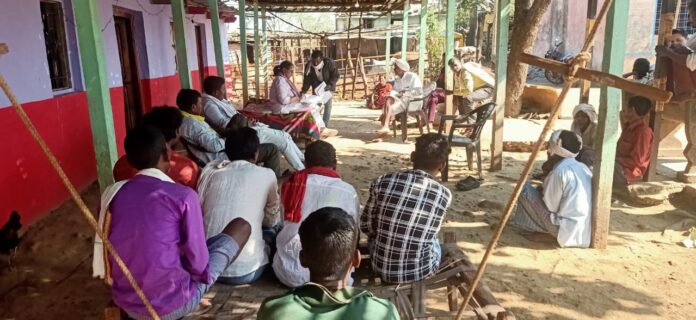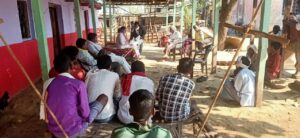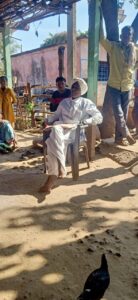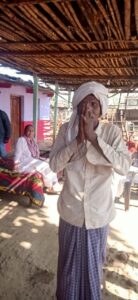
Kolams in Ghatraiguda – a Precarious Existence

Growing cotton, jawari, ambadi and some lentils is the basic livelihood of the Adivasis in Jivti. If they are driven out of their land, their community life is destroyed and they migrate from place to place looking for wage labour. Today the condition of Adivasis in Jivti is extremely precarious. Many have already been forcibly dispossessed on their land by non-tribal outsiders, left their homes and hearths and fled to other places and many others are on the verge of losing it.
Ghatraiguda is a hamlet of Kolam tribals with barely twenty households. The track leading to the hamlet leads to the zilla parishad primary school right at the edge of the village. It is a single block without a wall compound or playground and the walls need fresh coat of paint. The school occupies one side of the common court yard t the centre of which is the shrine of Bhuri Dev. Around the court yard are the kuchcha homes of the Kolams with barely any space between two – most of the huts have shared roofs and walls.

I sat outside the home of Maroti Atram, the Gaon Patil and he narrated the story of the village. Kolams have lived in this spot in the past in the 1950s. At some point they went a little distant away, proably to be closer to their fields. It was also called Ghatraiguda. The non-tribals came and attacked them at night and threw stone at their huts. The non-tribals came in greater numbers and the tribals ran away from the hamlet. Some of them went to Limguda (Nimguda) in Telengana, others like Maruti Patil himself went to Sitaguda. They continued to cultivate their plots of land in the forest. They remained connected to Ghatraiguda – their Aadhar cards note the address as Ghatraiguda.
In 2004 they decided to come back to the original Ghatraiguda where they lived more than fifty years ago. But some non-tribals had encroached upon the land and started cultivating cotton on it. The Adivasis showed the 7/12 extract in the name of one non-tribal which showed that he cultivated 2:00 hectares in survey no. 3 paiki and the mutation no. 137 vatap adhare. It is quite possible that this is a completely bogus 7/12 and the mutation number is false.
Further, there is a patta issued under Rule 8 (J) of the Forest Rights Act, 2006 which shows a minuscule 0.572 hectares in compartment no.102 given to the Gram Sabha for homestead land gaothan. This probably means that Ghatraiguda is situated on forest land. It is not clear how there is 0.572hectares of forest land located in the midst of private agricultural lands?
Although the Adivasis were given CFR pattas under FRA, when the forest department officials came to measure the land, they were threatened by the non-tribals and left without measurement. Usually the forest department acts in a very powerful manner when it comes to evicting Adivasis, and it is quite inexplicable how they became so weak when it came to evicting the non-tribals of Ghatraiguda.
Today the Adivasis live a precarious life in the hamlet which is squeezed between the cotton fields of two non-tribals. The hamlet is so small that there is no space for school. A few years back, the government wanted to construct an Anganwadi but that could not be done because there was no place. Instead of removing the encroachments of the non-tribals, the government decided not to construct an Anganwadi for the Kolams.

Paggu Gangu Sidam who does not have a house in the gaothan and lives with his family in a hut constructed on his plot of land. He was pleading for some place in a gaothan to build home.
The Kolams have appealed to the authorities for help but there is no response from the administration yet. If the administration does not take strong steps to support the Kolams who fall in the category of Particularly Vulnerable Tribal Group, it would be impossible to ensure their survival.
- Paromita Goswami


